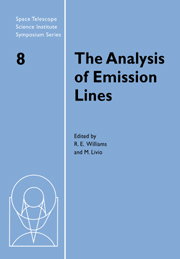Book contents
- Frontmatter
- Contents
- Participants
- Preface
- Emission Lines: Past and Future
- Atomic Data for the Analysis of Emission Lines
- Radiative Transfer
- Emission Lines from Winds
- Photoionizing Shocks
- The Lexington Benchmarks for Numerical Simulations of Nebulae
- Emission Line Diagnostics
- Ultraviolet Spectroscopy
- Infrared Emission Lines as Probes of Gaseous Nebulae
- Molecular Emission Line Diagnostics in Astrophysical Environments
- Abundance Determinations
- Astrophysical Gamma Ray Emission Lines
- Summary Remarks
Ultraviolet Spectroscopy
Published online by Cambridge University Press: 23 November 2009
- Frontmatter
- Contents
- Participants
- Preface
- Emission Lines: Past and Future
- Atomic Data for the Analysis of Emission Lines
- Radiative Transfer
- Emission Lines from Winds
- Photoionizing Shocks
- The Lexington Benchmarks for Numerical Simulations of Nebulae
- Emission Line Diagnostics
- Ultraviolet Spectroscopy
- Infrared Emission Lines as Probes of Gaseous Nebulae
- Molecular Emission Line Diagnostics in Astrophysical Environments
- Abundance Determinations
- Astrophysical Gamma Ray Emission Lines
- Summary Remarks
Summary
A review of the field of astronomical ultraviolet spectroscopy with emphasis on emission lines in astrophysical plasmas is presented. A brief history of UV spectroscopy instruments is given, followed by a discussion and tabulation of major atlases of UV emission-line objects to date (mid-1994). A discussion of the major diagnostic UV emission lines in the ∼ 912–3200Å spectral region that are useful for determining electron densities, temperatures, abundances, and extinction in low- to moderate-density plasmas is given, with examples of applications to selected objects. The review concludes by presenting some recent results from HST, HUT, and IUE on UV emission-line spectroscopy of nebulae and active galaxies.
Introduction
The history of ultraviolet (UV) spectroscopy in astronomy spans over three decades now and such observations have led to many discoveries regarding the physical nature of the entire gambit of astronomical objects. Hot astrophysical plasmas have line and continuum emission and absorption processes for which UV spectroscopy can probe the more energetic physical processes that cannot be studied adequately in the optical or infrared. In addition, studies of the UV spectral properties of cooler bodies, such as planetary atmospheres, comets, and interstellar dust provide important information on their physical state and composition.
This article concentrates on reviewing some of the techniques and results from the study of emission lines in astronomical UV spectroscopy. Given that the range of astronomical objects from the Earth's geocorona to quasars show UV emission lines and that during the past three decades over two thousand papers have appeared in the literature, including numerous conferences and books, a comprehensive review is unpractical.
- Type
- Chapter
- Information
- The Analysis of Emission Lines , pp. 107 - 133Publisher: Cambridge University PressPrint publication year: 1995
- 1
- Cited by



